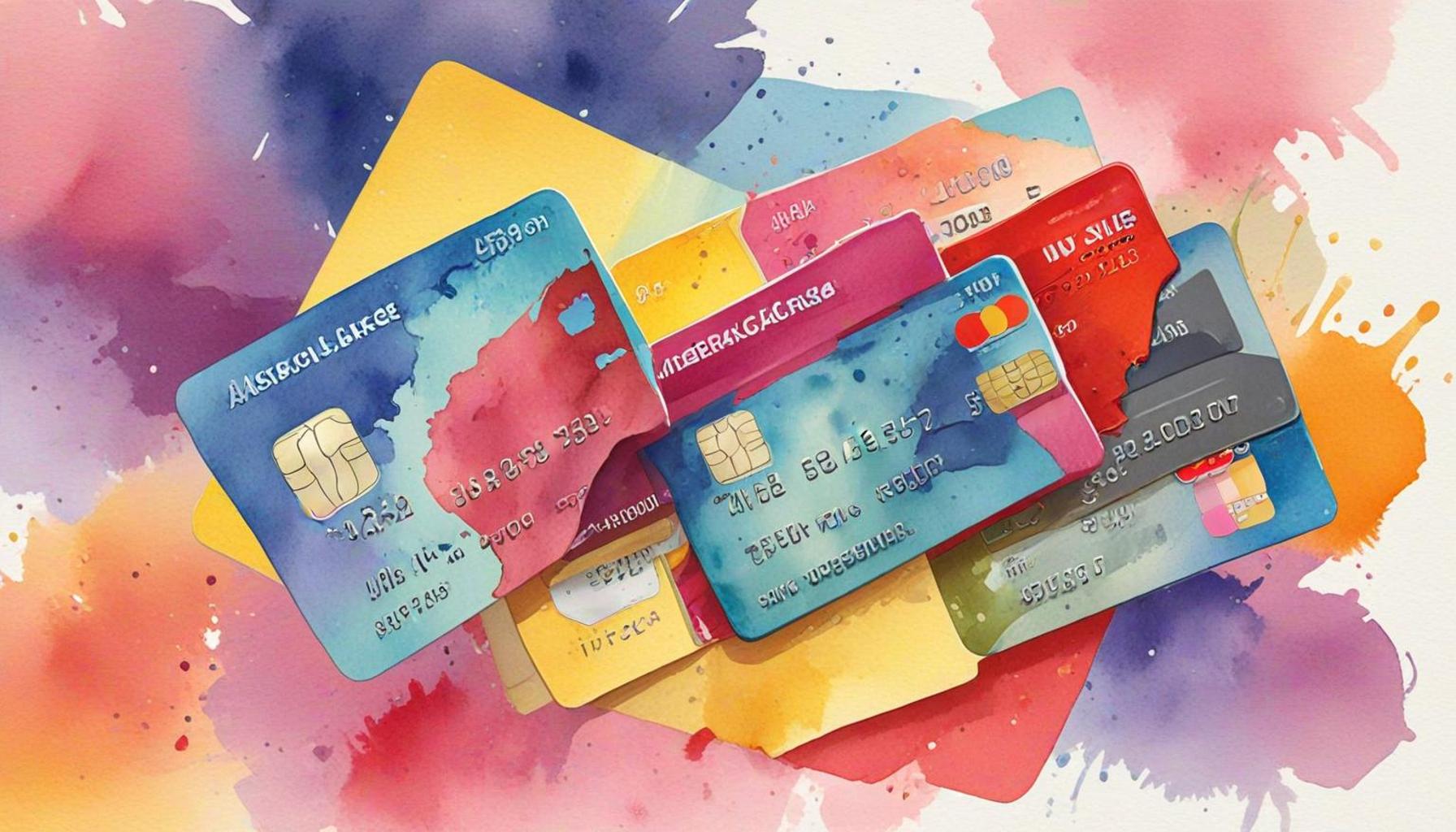Differences between types of American credit cards

Understanding Credit Card Varieties
The American credit card landscape is diverse, catering to a wide range of consumer needs. Each credit card type offers unique benefits and drawbacks, making it crucial for holders to understand their options. Key considerations include rewards, fees, and interest rates, which can significantly impact the overall financial health of cardholders. Awareness of these factors enables consumers to select a credit card that best aligns with their personal financial strategies and lifestyle choices.
Types of Credit Cards
- Cash Back Cards: Cash back credit cards allow consumers to earn cash rewards on purchases, frequently at a rate of 1% to 6% back depending on spending categories. For example, a typical cash back card may offer 5% on groceries and 1% on all other purchases. This type of card is particularly beneficial for consumers who regularly spend in higher-reward categories, allowing them to accumulate cash that can be redeemed for statement credits or direct deposits.
- Travel Rewards Cards: Travel rewards credit cards enable users to accumulate points or miles for travel-related expenses such as airfare, hotel stays, and car rentals. These cards often feature sign-up bonuses that can offer substantial rewards after meeting a spending threshold, making them attractive for frequent travelers. Some travel cards, like those affiliated with airlines, provide additional perks such as free checked luggage or access to airport lounges, significantly enhancing the travel experience.
- Balance Transfer Cards: Designed for individuals looking to consolidate existing debt, balance transfer cards typically come with lower promotional interest rates for a specified period, often 0% APR for the first 12 to 18 months. This can be advantageous for paying down high-interest debt more efficiently, as cardholders can allocate their payments towards principal rather than interest during the promotional window. However, it is essential to understand any balance transfer fees and the terms that apply once the introductory period ends.
- Secured Credit Cards: Secured credit cards are particularly well-suited for individuals aiming to build or rebuild their credit history. These cards require a cash deposit that serves as collateral and typically establishes the credit limit. Responsible usage and timely payments on secured cards can bolster a consumer’s credit score over time, opening the door to unsecured credit options in the future.
Each type serves different financial strategies. For instance, cash back cards are suited for those seeking immediate rewards on daily spending, while travel cards cater to frequent travelers looking to maximize their journeys. On the other hand, balance transfer cards appeal to those burdened with high-interest debt, offering a pathway to financial relief. Lastly, secured credit cards provide a foundational tool for those entering or re-entering the credit market. Understanding these differences allows for informed decisions that align with individual spending habits and financial goals.
In summary, the variety of credit cards available in the United States reflects the diverse needs of consumers. By weighing their options carefully and considering factors such as rewards, fees, and interest rates, consumers can strategically choose credit products that enhance their financial wellbeing and meet their specific needs.
SEE ALSO: Click here to read another article
Evaluating Credit Card Options
When considering the myriad of credit card types available in the United States, consumers must assess how each card aligns with their unique financial situations and spending patterns. Key features to evaluate include reward structures, annual fees, and interest rates. Making an informed decision can lead to substantial long-term savings or rewards accumulation. Below, we delve deeper into several prevalent types of credit cards and highlight their essential characteristics, advantages, and potential drawbacks.
Cash Back Cards
Cash back cards offer a straightforward rewards system that allows consumers to earn a percentage of their spending back as cash. Depending on the card, cash back can vary by category; for instance, one card may offer 3% cash back on dining and 1% on all other purchases, while another might provide a higher percentage on grocery purchases. These cards are often ideal for consumers who prefer immediate, liquid rewards instead of points or miles. However, some cash back cards may charge an annual fee that could offset potential rewards, so consumers should weigh these factors carefully.
Travel Rewards Cards
For those who frequently travel, travel rewards cards can be particularly advantageous. These cards allow users to earn points or miles on travel-related expenses, which can be redeemed for flights, hotels, or other travel perks. Many travel cards come with significant sign-up bonuses, enticing users to reach a spending threshold in exchange for a large influx of points. In some instances, these cards are affiliated with specific airlines, providing perks such as priority boarding or increased baggage allowances. Despite their benefits, potential cardholders should scrutinize foreign transaction fees, as these can counteract the value of rewards while traveling abroad.
Balance Transfer Cards
Balance transfer cards cater to individuals seeking relief from high-interest debt. These cards often offer an introductory period with 0% APR for balance transfers, allowing cardholders to pay off existing debt without accruing additional interest. This feature can significantly aid in debt management, allowing for accelerated repayment of principal amounts. However, it is imperative for consumers to read the fine print carefully, as balance transfer fees may apply, and the standard interest rate after the promotional period can be high if substantial balances remain.
Secured Credit Cards
Secured credit cards are designed primarily for individuals looking to build or rebuild their credit scores. Requiring a cash deposit that serves as collateral, these cards often have lower credit limits than traditional unsecured cards. However, they can be an effective tool for establishing a positive credit history when used responsibly. Timely payments and prudent credit utilization can lead to improved credit scores, paving the way for future access to unsecured credit options. It is important for consumers to consider the fees associated with secured cards, as some may charge monthly fees that could impact long-term credit-building efforts.
In summary, understanding the varying types of American credit cards is crucial for consumers to make informed decisions that resonate with their financial strategies. Whether focusing on immediate cash rewards, travel incentives, debt consolidation, or credit building, comprehending these differences empowers users to select the best options tailored to their lifestyles.
CHECK OUT: Click here to explore more
Understanding Additional Credit Card Types
Alongside the commonly known cash back, travel rewards, balance transfer, and secured credit cards, there exists an array of specialized credit card types tailored to specific consumer needs and preferences. Each of these cards offers unique benefits and features that cater to various spending behaviors and financial goals. Below, we explore a few additional categories to provide a comprehensive overview of American credit card options.
Student Credit Cards
Student credit cards are specifically designed for college students who are new to credit. These cards typically have lenient application requirements, allowing students with little or no credit history access to credit. Many student credit cards offer reward programs similar to cash back or points, encouraging young adults to develop responsible spending habits while they build their credit scores. Additionally, these cards often come with educational resources and tools to help students understand credit management. However, students should be vigilant about potential fees, including late payment penalties, which could hinder their financial progress.
Loyalty and Co-branded Credit Cards
Loyalty cards or co-branded credit cards are affiliated with specific brands, including retail stores, airlines, or hotel chains. These cards reward users for frequent purchases with enhanced benefits tailored to the respective brand. For instance, a co-branded airline credit card may offer extra miles on airline bookings and perks such as waived luggage fees. These cards are advantageous for consumers who are brand loyal and can maximize the rewards by spending within the associated ecosystem. However, users should be cautious of the restrictions often placed on rewards redemption, which may limit flexibility and utility.
Premium Credit Cards
Premium credit cards are targeted at high earners and typically come with a variety of exclusive benefits. These cards often boast elevated annual fees but compensate with a host of perks such as concierge services, access to private events, subscription services, and higher reward rates on a wide range of purchases. Some premium cards include travel protections like trip cancellation insurance and rental car coverage, enhancing the value for frequent travelers. However, to truly benefit from these offerings, cardholders must ensure their spending habits align with the card’s features to justify the costs associated with maintaining premium benefits.
Business Credit Cards
Business credit cards are crafted specifically for entrepreneurs and small business owners. These cards typically provide higher credit limits, facilitating larger purchases and operational expenses. Many business cards reward account holders with points or cash back on categories that may align with business expenditures, such as office supplies or travel. Additionally, these cards often feature expense tracking tools that help business owners manage finances more efficiently. On the downside, business credit cards can impact personal credit scores if not managed properly, highlighting the importance of responsible usage.
Charity and Non-Profit Credit Cards
For consumers looking to contribute to philanthropic causes, charity credit cards offer a unique avenue for supporting non-profit organizations. These cards donate a percentage of every purchase to a designated charity, allowing cardholders to make a positive impact while managing their expenses. While the intent is admirable, potential users should assess whether the donation percentages are meaningful in relation to the potential costs of card fees and interest rates.
The diverse spectrum of credit card types available in the American market caters to various financial goals, spending habits, and lifestyles. By thoroughly evaluating these options, consumers can select the most advantageous card types that align with their personal and financial aspirations.
SEE ALSO: Click here to read another article
Conclusion
In summation, understanding the various types of American credit cards is essential for consumers seeking to optimize their financial strategies and spending habits. From the practical offerings of student credit cards aimed at those new to credit, to the lucrative benefits associated with premium and co-branded cards, each card type is designed with specific user needs in mind. Business credit cards cater to entrepreneurs by providing essential tools for expense management, while charity cards allow for a unique avenue of philanthropy through everyday spending.
As consumers evaluate their credit card options, it is crucial to assess not only the reward structures and benefits but also the potential fees and limitations tied to each card. For instance, understanding the restrictions on rewards redemption in loyalty cards, or recognizing how annual fees on premium cards may impact the overall value they provide will serve to enhance informed decision-making. Ultimately, aligning one’s credit card choice with personal financial goals, spending behaviors, and lifestyle preferences can significantly bolster one’s financial health and long-term success.
Consumers should take the time to research, compare, and choose wisely, ensuring their selected credit card complements their economic needs and aspirations. Being an informed cardholder can lead to maximizing rewards, minimizing costs, and fostering a positive credit history.

Beatriz Johnson is a seasoned financial analyst and writer with a passion for simplifying the complexities of economics and finance. With over a decade of experience in the industry, she specializes in topics like personal finance, investment strategies, and global economic trends. Through her work on Território Deficiente, Beatriz empowers readers to make informed financial decisions and stay ahead in the ever-changing economic landscape.






